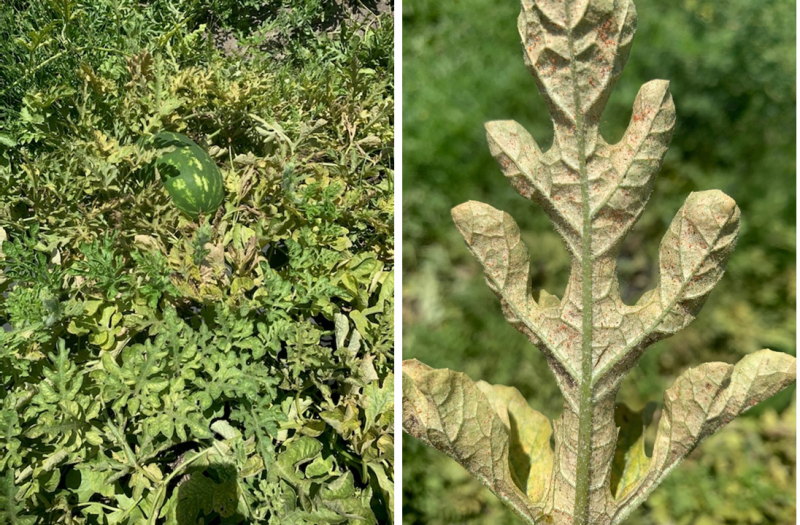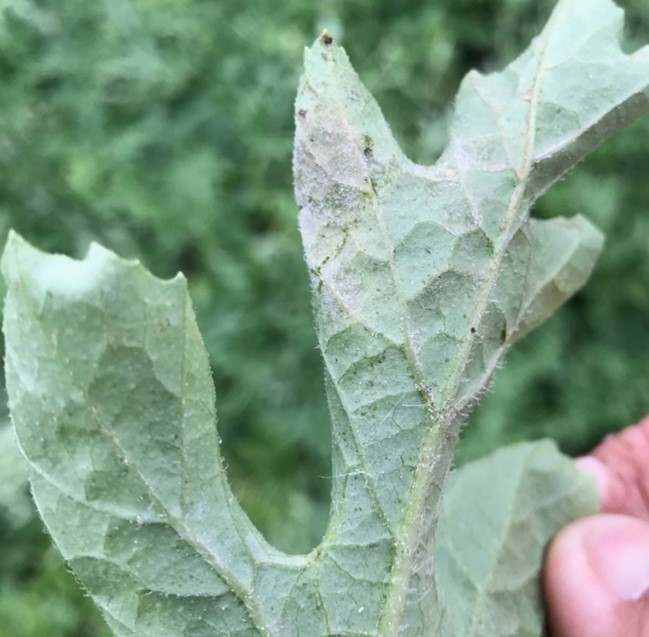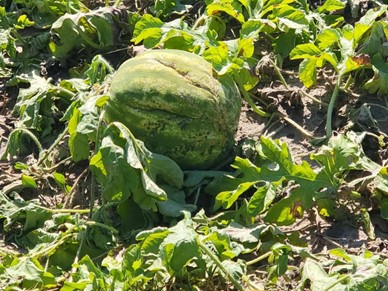Bob Hochmuth, Regional Specialized Extension Agent- Vegetable Crops – Before being combined, original articles were published May 7 & 15, 2023
Welcome to the 2023 growing season, weekly issue of the UF/IFAS Extension Suwannee Valley Watermelon Crop Update. These updates are summarized by Bob Hochmuth, Regional Specialized Extension Agent- Vegetable Crops, with input from Suwannee Valley Extension Agents: Mark Warren (Levy), Tyler Pittman (Gilchrist), Tatiana Sanchez (Alachua), Luke Harlow (Bradford), Jay Capasso (Columbia), Dan Fenneman (Madison), Keith Wynn (Hamilton), Emily Beach (Lafayette), Jim Devalerio (Union), De’Anthony Price (Jefferson), Bob Hochmuth (for vacant Suwannee position), Kevin Athearn (RSA-Agri- business), and Sudeep Sidhu (RSA- Water Resources).
–
First Powdery Mildew Confirmation This Year
Late last week, powdery mildew was confirmed in the Suwannee Valley region. This discovery has been expected for a couple weeks now and perhaps has been delayed due to the early initiation of sprays for powdery mildew over the past couple weeks. If you are concerned about powdery mildew or have not already started sprays for powdery mildew, we are still suggesting rotating targeted products such as Procure or Quintec in combination with broad spectrum fungicides such as Mancozeb. Initial symptoms appear as circular yellow areas on the leaves. As the infection progresses, powdery growth of the fungus appears and can be seen initially on the underside of the leaves (see photo below and pages 36-37 in the IFAS Watermelon Field Guide). Eventually the “white powder” can be found on both surfaces of the leaves and stems as the tissue decays. (Tatiana Sanchez and Bob Hochmuth. Thanks to De Broughton, 6Gen Ag Services for detecting and submitting saples).
–
Alternaria leaf spot and leaf blight
Over the past two weeks, we have submitted several watermelon leaf samples from the Suwannee Valley region. Interestingly enough, one of the most common diseases detected in samples this spring has been Alternaria species (see pages 28-29 in your IFAS Watermelon Field Guide). In fact, the first downy mildew confirmation last week also had Alternaria, and most of the “ugly” lesions in that sample were actually Alternaria species, although both diseases were found in that sample. Alternaria alternata is the causal agent of Alternaria leaf spot, and Alternaria leaf blight is caused by Alternaria cucumerina, though these disease names are sometimes used interchangeably. Alternaria sp. occur on many cucurbit crops including cantaloupe, watermelon, summer squash, cucumber, musk melon, etc. Alternaria has traditionally been considered a minor disease of watermelon. However, this year and the past couple years, Alternaria has become much more common and quite concerning in some fields. Symptoms begin on the upper surface of older leaves as very small yellow or tan spots that may be surrounded by light green or yellow halos or by a water-soaked area. The spots later grow up to ¾ of an inch (2 cm) in diameter and turn brown in color. Similar in appearance to gummy stem blight, the lesions are the source of spores, which are spread primarily by wind. Under severe infestations, the disease produces some defoliation and can lower yields. This fungus can survive on or in crop debris, with debris on the surface more likely to spread spores because of exposure to the wind. Volunteer cucurbit plants and weeds, such as balsam apple, are also sources of inoculum. When watermelons are planted successively for multiple harvest dates, older infested plants located upwind can also contribute to disease spread. Although wind is the main vehicle for spore dispersal, movement by rain splash and mechanical means can also occur. As in other fungal diseases, spores require moisture to germinate and enter the leaf tissue, while spore release from the plant is best achieved under dry conditions. The optimum temperature for infection is 68°F. There are 3 to 12 days from spore penetration until the next group of spores is released. Fungicides typically used at this time of the season for diseases like gummy stem blight, which are also effective against Alternaria include: Inspire Super, Aprovia Top, and Miravis Prime. The older fungicide, Pristine, is also effective against Alternaria. (Bob Hochmuth, edited from UF/IFAS Plant Diagnostic Center)
–
Spider Mites Detected
We had two reports of early infestation of spider mites in the last week or so. This pest is more common in dry weather, so in areas that had been missing rainfall before last week, spider mites would not be a surprise. Unlike disease warnings, spider mites are generally very isolated and do not represent a call to action across the region, but keep up a good scouting program and be on the lookout for small patches of bronzed leaves typical of spider mite feeding. It is common to see these infestations along the edges of the fields where the mites may have moved in from weedy borders. See pages 104-105 in your UF/IFAS Watermelon Field Guide. (by Bob Hochmuth. Thanks to Steve Hoak, Ag Consulting Solutions, and De Broughton, 6Gen Ag Services for reporting these)

Left- spider mite damage. Right-close up of underside of a leaf with spider mites. Credit: Bob Hochmuth, UF/IFAS
–
Watermelon Mosaic Virus
We are seeing much more watermelon mosaic virus in fields as we approach harvest. The leaf symptoms are mottled greenish/grayish colors, especially on new leaves. This virus is transmitted by aphids and little can be done to stop this infection. So, do not spray for mosaic virus now thinking it will do some good. Usually, we see mosaic virus on the perimeters of fields due to aphids moving into the fields from hedgerows or wooded areas where they overwinter. See pages 44-45 in your IFAS Watermelon Field Guide). (Bob Hochmuth)
–
Lightning Strike
One of the most interesting things we see in watermelon fields is the result of a lightning strike. The power of the electricity in a strike “etches” a line across the watermelon fruit through the vines laying on the fruit. In addition, we often see a hole melted or blown in the drip tape or plastic mulch. The first reported case was from last week. See the photo below and also refer to pages 66-67 in your IFAS Watermelon Field Guide. (Mark Warren and Bob Hochmuth)
–
Harvesting and Worker Health
Many farms have started harvesting over the past 7-10 days and things are well under way. Strong demand is expected to continue, so we hope for the best in the upcoming weeks. Remember to keep the work force healthy and protected from dehydration and excessive sun exposure (water, sunscreen, hats, and clothing to protect the workers). UF/IFAS and UF Health Cancer Center have educational programming in place should you want additional information on worker health. Contact your County Extension Agent for further information on this program. (Bob Hochmuth)
–
Foliar Fertilizer Cautions
When we have strong market prices, it is more common to hear or get questions regarding all kinds of foliar nutrition recommendations. I feel like I need to communicate a cautionary tale here. In my long career, I assure you that I have seen more problems with significant burn as a result unwise foliar fertilizer applications than I have ever seen as good. That being said, I am not saying foliar nutrition is never needed! However, we have so much technology and sampling information available to us today, we can make educated sensible decisions based on knowledge specifically for your farm. We have excellent guides for leaf tissue nutrient levels for all vegetable crops and this information has proven to be an excellent guide: Plant Tissue Analysis and Interpretation for Vegetable Crops in Florida. Also, my preference is usually to fertigate, not spray, in most instances when a specific nutrient is needed. A “shotgun” approach to foliar feeding the crop is almost assured to be not only costly, but unwise and risky for burn, especially when mixed in a tank with other chemicals. Macronutrients such as nitrogen, phosphorus, potassium, magnesium, sulfur, etc. if needed to correct a deficiency, are needed in greater quantities than what leaves can typically absorb without first burning the foliage, so be very careful there. Of course nitrogen and potassium are the two we typically fertigate anyway. The other macronutrient to discuss is calcium which is in very high levels in our water (60-80 ppm Ca) because we are pulling from a limestone aquifer full of calcium. That source of calcium in this region is very important because calcium is picked up by root tips and transported in the water stream. It is very difficult to correct a calcium deficiency with foliar applications because the leaves do not move calcium very well to other parts the plant such as the fruit. If calcium is needed in addition to the calcium supplied in our water, lime, etc., then calcium nitrate as part of our liquid fertigation solution is a far better source than spray applications, but use your leaf tissue data to guide your decisions. Some micronutrients like manganese and zinc are ingredients in some of our commonly used fungicides, such as mancozeb, so your regular fungicide programs often cover you with these two micronutrients. As we have covered before, copper can be toxic to watermelons, but our applications of copper for bacterial diseases early in the season generally give us more copper than we will ever need. The final micronutrient to note here is boron. The micronutrient, boron, is very important in root tip growth and during bloom including pollen tube development. This is where regular leaf tissue analysis also can be very helpful, especially early in the season. Boron levels should be in the range of 20 ppm or higher and if higher than 20 ppm, the likelihood of any benefit from boron sprays is very small. Late season boron applications are even less likely to be needed. If boron is needed early in the season during the main bloom period, add it via fertigations at the recommended rate. You can have your supplier add boron to the 8-0-8 or other liquid solutions at a rate that will meet the crop needs. I go back here to my philosophy, if we know we are deficient in a specific nutrient, consider adding it via fertigations, not as part of a “shotgun” spray and definitely not in a “cocktail” of several chemicals. Remember, in all of this discussion, I have not said additional nutrient applications are never needed, but I have suggested here to use information available to you to make educated and wise decisions, AND, reduce the risk of unnecessary burn to the crop. (Bob Hochmuth)
–
SV Rapid Diagnostic Watermelon Program
We have initiated a more formal way to support our watermelon growers with a rapid diagnostics system through Suwannee Valley Regional and County Extension Agents. This industry-funded program allows Extension Agents to submit and pay for watermelon grower’s plant disease and other diagnostic samples. This SV Rapid Diagnostic Watermelon Program will help us to get quicker diagnostic results, helping to give early alerts to everyone, and not have to charge the growers directly. Sponsors of this program in 2023 to date include Harrell’s, TriEst Ag, Gowan USA, and Syngenta Crop Protection. Company representatives interested in sponsoring can contact Bob Hochmuth at bobhoch@ufl.edu or 386-288-6301.
- 2024 Watermelon Season Wrap Up - June 21, 2024
- Weekly Watermelon Update – June 3 - June 7, 2024
- Weekly Watermelon Update #10 – May 20 - May 24, 2024



